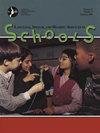Embedding Social-Emotional Learning in Elementary School-Based Speech-Language Therapy: A Pilot Randomized Controlled Trial.
IF 2.9
3区 医学
Q1 AUDIOLOGY & SPEECH-LANGUAGE PATHOLOGY
Language Speech and Hearing Services in Schools
Pub Date : 2025-08-08
DOI:10.1044/2025_lshss-25-00001
引用次数: 0
Abstract
PURPOSE Many students with communication disorders have unique social-emotional needs, yet school speech-language pathologists (SLPs) are not typically trained in how to address those needs. We developed a new training (STIRS [SLP Training to Increase Resilience in Students]) to equip elementary school SLPs to embed social-emotional learning (SEL) practices within their routine speech-language sessions with K-3 students with communication disorders. The primary objective of this pilot trial was to evaluate the preliminary effects and feasibility of STIRS. METHOD This was a single-blind, parallel two-arm pilot randomized controlled trial with elementary school SLPs within a local education agency in Iowa. At a scheduled professional development meeting, the SLPs were randomly assigned to either the STIRS condition or active control condition (speech assessment of bilingual students). Both conditions involved a one-time 3-hr training. SLPs' attitudes, knowledge, and self-efficacy in addressing SEL with their K-3 students were measured immediately before and after the training. After the training, we also collected data on acceptability, appropriateness, and feasibility to inform a future definitive trial. RESULTS Twenty SLPs who attended the professional development meeting consented to participate, were randomized by remote web-based allocation, and completed both pretraining and posttraining measures (12 SLPs in the STIRS condition and eight in the active control condition). Compared to the control group, there was a small positive main effect of the STIRS training on SLPs' openness, knowledge, and self-efficacy immediately posttraining. The SLPs in the STIRS condition also reported adequate levels of acceptability, appropriateness, and feasibility of the training. CONCLUSIONS The one-time STIRS training has the potential to increase SLPs' willingness and confidence to support SEL of K-3 students with communication disorders. In a future definitive trial, engagement could be enhanced through more clinical application training. Enrollment challenges may be mitigated by using a different design (e.g., team-based coaching, waitlist control).在小学语言治疗中嵌入社会情绪学习:一项随机对照试验。
目的:许多有沟通障碍的学生有独特的社会情感需求,然而学校的语言病理学家(slp)并没有接受过如何处理这些需求的典型培训。我们开发了一种新的训练方法(STIRS [SLP training to Increase Resilience in Students]),使小学的SLP能够将社会情绪学习(SEL)实践融入到他们对K-3年级有沟通障碍的学生的日常语言教学中。本试验的主要目的是评估STIRS的初步效果和可行性。方法:在爱荷华州某地方教育机构对小学特殊学生进行单盲、平行、双臂先导随机对照试验。在预定的专业发展会议上,这些特殊语言学生被随机分配到STIRS条件或主动控制条件(双语学生的语言评估)。这两种情况都需要进行一次3小时的培训。在训练前和训练后立即测量了小学教师与K-3年级学生处理SEL的态度、知识和自我效能感。培训后,我们还收集了可接受性、适当性和可行性的数据,为未来的最终试验提供信息。结果20名同意参加专业发展会议的slp,通过网络远程分配随机化,完成了训练前和训练后的措施(STIRS组12名,主动对照组8名)。与对照组相比,STIRS训练在训练后立即对slp的开放性、知识性和自我效能感有小的正主效应。STIRS条件下的slp也报告了培训的可接受性、适当性和可行性。结论一次性的STIRS训练有可能提高小学3年级沟通障碍学生的SEL支持意愿和信心。在未来的决定性试验中,可以通过更多的临床应用培训来加强参与。注册挑战可以通过使用不同的设计来缓解(例如,基于团队的指导,候补名单控制)。
本文章由计算机程序翻译,如有差异,请以英文原文为准。
求助全文
约1分钟内获得全文
求助全文
来源期刊

Language Speech and Hearing Services in Schools
Social Sciences-Linguistics and Language
CiteScore
4.40
自引率
12.50%
发文量
165
期刊介绍:
Mission: LSHSS publishes peer-reviewed research and other scholarly articles pertaining to the practice of audiology and speech-language pathology in the schools, focusing on children and adolescents. The journal is an international outlet for clinical research and is designed to promote development and analysis of approaches concerning the delivery of services to the school-aged population. LSHSS seeks to advance evidence-based practice by disseminating the results of new studies as well as providing a forum for critical reviews and meta-analyses of previously published work.
Scope: The broad field of audiology and speech-language pathology as practiced in schools, including aural rehabilitation; augmentative and alternative communication; childhood apraxia of speech; classroom acoustics; cognitive impairment; craniofacial disorders; fluency disorders; hearing-assistive technology; language disorders; literacy disorders including reading, writing, and spelling; motor speech disorders; speech sound disorders; swallowing, dysphagia, and feeding disorders; voice disorders.
 求助内容:
求助内容: 应助结果提醒方式:
应助结果提醒方式:


